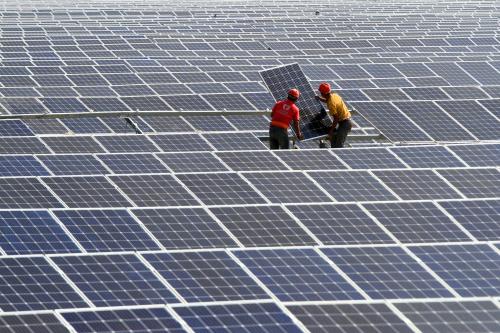It is turning out to be quite a three days in Beijing. It’s not certain whether the meeting between Japanese Prime Minister Shinzo Abe and Chinese President Xi Jinping will herald a de-icing of bilateral relations, but the steps occurring between the U.S. and China seem positive–at least to a degree.
New deals on trade in electronic products and visa procedures promise a global economic boost. (Bigger trade deals are being pursued in a somewhat competitive fashion as Washington and Beijing seek their own frameworks.) Plans to curb greenhouse-gas emissions and a deal accelerating the sharing of climate-friendly technologies could boost the effort to address global climate change.
Potentially as important are two military accords reportedly near completion that, taken together, could substantially reduce risks in the security sphere that could threaten the entire relationship.
The two prospective agreements would apparently cover close approaches involving vessels and aircraft on the high seas and in international airspace, as well as large-scale military maneuvers, including exercises. Military-to-military hotlines at the operational level would be created to facilitate information exchanges. Ideally, the agreement on vessels and aircraft would involve not just naval ships but also Coast Guard fleets, fishing boats, commercial aircraft, and virtually all other ships or planes. China, tired of U.S. reconnaissance operations near its coasts (albeit beyond the 12-mile territorial limit widely recognized in international law), has occasionally interfered with the safe operations of U.S. military assets in the region. Ideally, forthcoming accords would dramatically reduce such behavior.
These measures are among the two dozen that Jim Steinberg and I proposed in our book, “Strategic Reassurance and Resolve: U.S.-China Relations in the 21st Century.” They fall under confidence-building and operational safety issues. Other key categories cover military modernization, overseas basing, and strategic issues (which include cyber, space, missile, missile defense, and nuclear matters).
The Obama and Xi teams should be proud of a good summit. But situating these accords in a broader framework underscores how much work remains to be done. Within the confidence-building realm there is more to do, partly to convince China that it must accept the ongoing presence of U.S. military assets in the western Pacific, where the U.S. has enduring interests and close allies. Washington could do more to help, including proposing an “open skies” treaty–modeled on the NATO-Warsaw Pact accord–that would give China some reciprocal access to U.S. airspace for certain forms of monitoring and confidence-building operations.
More needs to be done to address cyber issues, largely by China. Space operations offer opportunities for arms control that could help build confidence as well. And on military modernization and defense budget issues, both sides need to look for opportunities to show restraint to help avoid a security dilemma and an arms race. China needs to think about moderating the pace of its general defense buildup and its missile threats to Taiwan; the United States needs to rethink some of the more potentially threatening aspects of its Air-Sea Battle concept.
But on balance, this summit is fostering a step forward.
This opinion originally appeared on Wall Street Journal’s Washington Wire.


Commentary
Op-edThe U.S.-China Deals: What Comes Next?
November 11, 2014